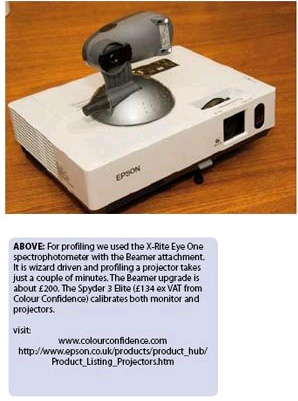articles/Digital/projectingyourimage-page3
Projecting Your Image - part 3 of 1 2 3
by Mike McNamee Published 01/02/2008

Within the profile, all projectors were targeted at 6,500°K and a gamma of 2.2. The 'measured' white points were between 7,550°K and 10,500°K. Changing the settings on the actual projector produced shifts of about 300 or 400°K but nothing to bring the values down to the target 6,500°K. The most neutral was the Epson followed by a slightly warm Mitsubishi and a very cool Optoma. In all cases the differentiation of shadow and highlight detail was maintained in the profiled projector screen image. The Optoma was, by some way, the poorest on quality and was biased in different directions between shadows and highlights. This was not eliminated by the making of a profile, but at least the Macbook was able to use one profile for the screen and another for the projector. The gamut volumes mark the Mitsubishi the highest scorer followed by the Epson. The 2005 HP VP6121 was a long way behind with a gamut volume that was only 22 per cent of the Mitsubishi - it did not, however, look five times worse.
The Technical Differences Between LCD and DLP
LCD (liquid crystal display) projectors usually contain three separate LCD glass panels, one each for red, green, and blue components of the image signal being fed into the projector. As light passes through the LCD panels, individual pixels ('picture elements') can be opened to allow light to pass or closed to block the light, as if each little pixel were fitted with a Venetian blind. This activity modulates the light and produces the image that is projected onto the screen.
DLP ('Digital Light Processing') is a proprietary technology developed by Texas Instruments. It works quite differently from LCD. Instead of having glass panels through which light is passed, the DLP chip is a reflective surface made up of thousands of tiny mirrors. Each mirror represents a single pixel.
In a DLP projector, light from the projector's lamp is directed onto the surface of the DLP chip. The mirrors wobble back and forth, directing light either into the lens path to turn the pixel on, or away from the lens path to turn it off. The spinning disc changes the projected colour through red, green and blue. Some people are sensitive to thie flickering effect that this creates - digital cameras certainly are, see the picture!
One benefit of LCD is that it has historically delivered better colour saturation than you get from a DLP projector. LCD also delivers a somewhat sharper image than DLP at any given resolution. The difference here is more relevant for detailed financial spreadsheet presentations than it is for video. This is not to say that DLP is fuzzy - it isn't. When you look at a spreadsheet projected by a DLP projector it looks clear enough. It's just that when a DLP unit is placed sideby- side with an LCD of the same resolution, the LCD typically looks sharper in comparison.
The Advantages of DLP Technology
There are several unique benefits that are derived from DLP technology. One of the most obvious is small package size, a feature most relevant in the mobile presentation market. Since the DLP light engine consists of a single chip rather than three LCD panels, DLP projectors tend to be more compact. All of the current three-pound miniprojectors on the market are DLPs. Most LCD projectors are five pounds and up. Another DLP advantage is that it can produce higher contrast video with deeper black levels than you normally get on an LCD projector. DLP has ardent followers in the home theatre world primarily due to this key advantage
gleaned from the projectorcentral website,quoted with a government health warning!
Please Note:
There is more than one page for this Article.
You are currently on page 3 Contact Mike McNamee
1st Published 01/02/2008
last update 09/12/2022 14:58:16
More Digital Articles
There are 37 days to get ready for The Society of Photographers Convention and Trade Show at The Novotel London West, Hammersmith ...
which starts on Wednesday 14th January 2026





